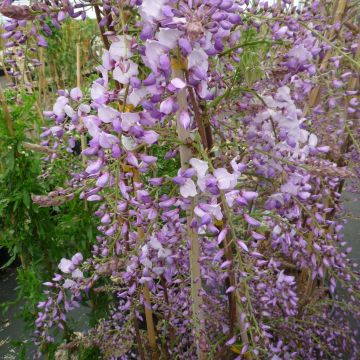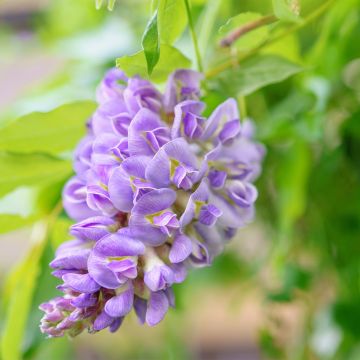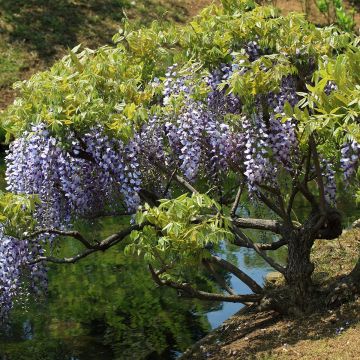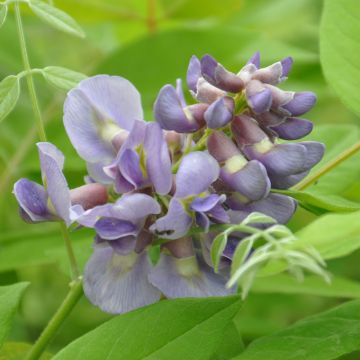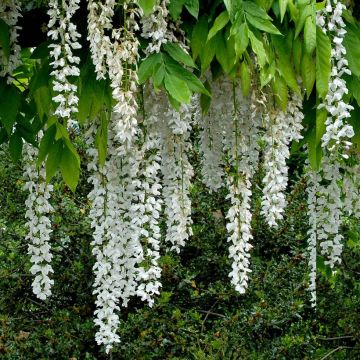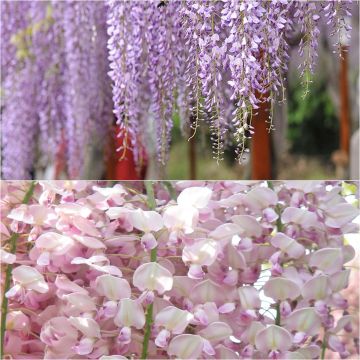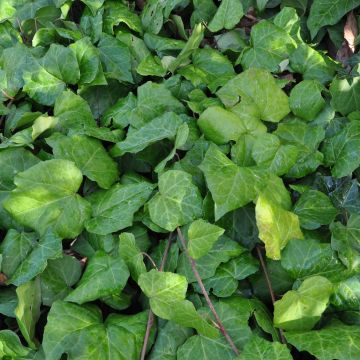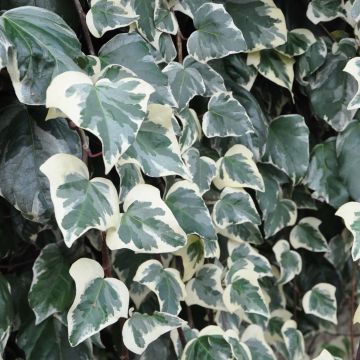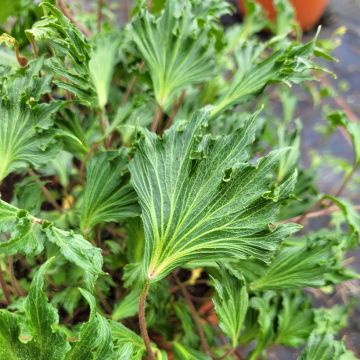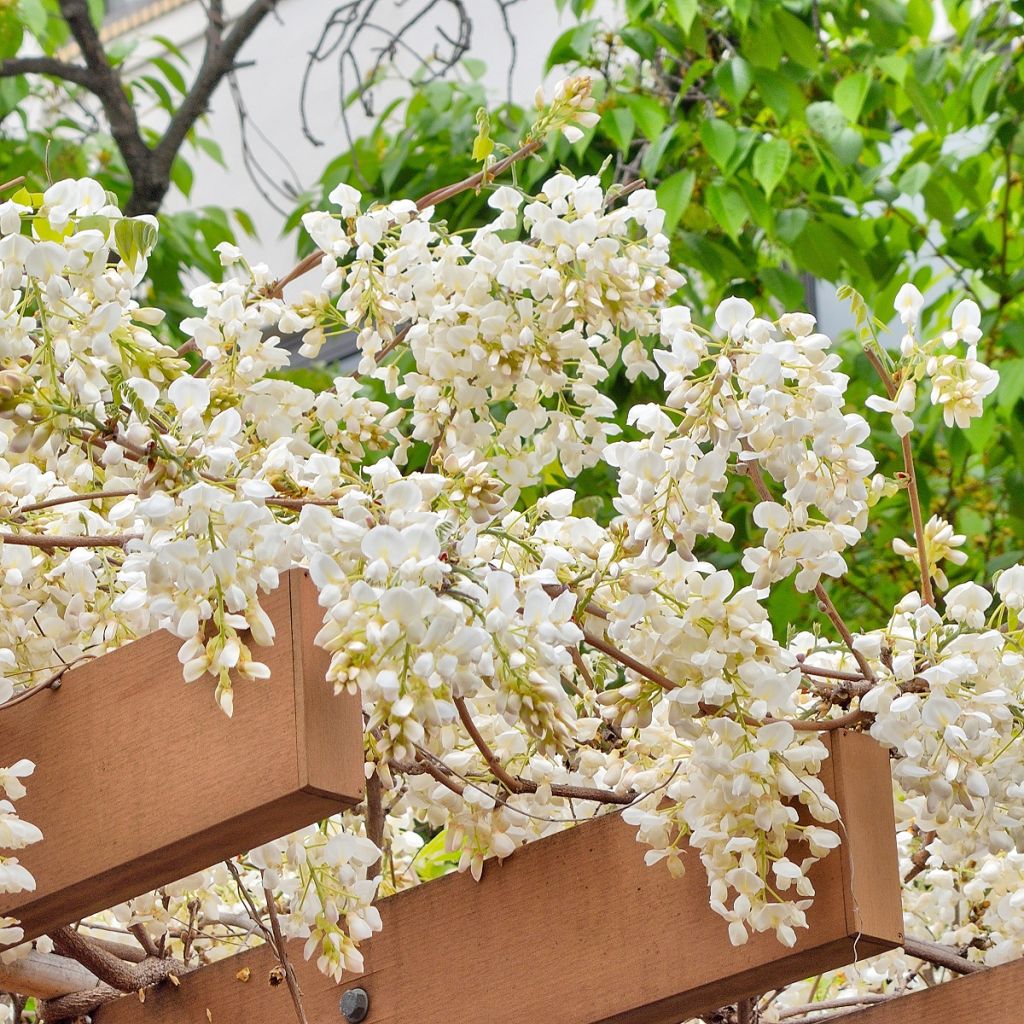

Wisteria brachybotrys White Silk
Wisteria brachybotrys White Silk
Wisteria brachybotrys White Silk
Silky wisteria, Silken wisteria
This plant carries a 6 months recovery warranty
More information
We guarantee the quality of our plants for a full growing cycle, and will replace at our expense any plant that fails to recover under normal climatic and planting conditions.
Oversize package: home delivery by special carrier from €6.90 per order..
Express home delivery from €8.90.
Does this plant fit my garden?
Set up your Plantfit profile →
Description
Wisteria brachybotrys 'White Silk' is derived from a highly floriferous species recognisable by its short but divinely scented clusters of pure white flowers. They bloom abundantly in spring, among the young leaves, even on young plants. This highly voluble and vigorous climbing plant is much less exuberant than its Chinese cousin, making it suitable for smaller gardens. It is hardy and thrives in most non-calcareous soils, in sunny locations.
Wisterias belong to the Fabaceae family, formerly known as Leguminosae, a group so vast that it has been divided into three subfamilies: Mimosoideae (acacia, commonly and mistakenly called mimosa, inga, calliandra), Caesalpinioideae (including the well-known cercis and gleditsia in temperate climates), and Fabaceae, recognisable by their papilionaceous flowers (colutea, caragana, genista, etc).
Wisteria brachybotrys (synonym W. venusta) is commonly known as silky wisteria, due to its young silky grey foliage. It is a climbing plant native to the Far East, but less vigorous than its Chinese cousin (W. sinensis) or Japanese wisteria (W. floribunda). This makes it ideal for small gardens or to adorn more compact pergolas without the risk of invasion.
'White Silk' generally reaches a height of 5 to 6m (16 to 20ft) and a width of 4 to 5m (13 to 16ft), but can grow beyond that if it is never pruned. Its voluble stems bear bright green leaves divided into 9 to 13 ovate leaflets, measuring 4 to 7cm (2 to 3in) in length. Its stems twist anti-clockwise around solid supports. The abundant flowering takes place in May-June, at the same time as the soft and touchable young foliage unfolds. It takes the form of pendant clusters, 15 to 20cm (6 to 8in) long. They are highly fragrant and attractive to bees. The clusters are shorter and more compact than those of Chinese wisteria, but are equally decorative with their beautiful pure white colour. The upper petal, called the "standard" due to its larger size, bears a discreet yellow spot in its centre. The flowers develop into toxic fruits in the form of flat pods that eventually open, expelling large dark seeds. The mature foliage turns yellow in autumn before falling.
This wisteria grows well in most acidic to neutral soils, and even slightly calcareous ones (in this case, dig a planting hole large enough to mix compost and topsoil with the existing soil). It is very hardy (down to -20°C (-4°F) or even lower). It blooms from a young age, especially when lateral shoots are pruned to 2 to 3 leaves to encourage floral clusters. Prune after flowering and later, if necessary, to limit its growth.
This wisteria is perfect for covering a wall, railing, pergola, arbour, or porch in a romantic garden, including smaller ones. While wisteria branches can often twist even the strongest support, this variety is much more "respectful". Few people know that it is possible to train Wisterias brachybotrys "as a tree". Simply plant a hollow galvanised steel tube in the ground, place 3 or 4 "petals" made of twisted reinforcing steel at its upper end, pushing them into the tube to hold them in place, thus forming a support that resembles a flower. Then plant 'White Silk' and the purple-flowered W. 'Okayama' at the base of this support. In the first year, weave the shoots of both plants around the support until they reach the reinforcing steel, then guide them to cover the support you have created. After 3 to 4 years, the metal structure will disappear under the stems and foliage, and passersby will stop in awe to contemplate the magnificent scene you have created!
Report an error about the product description
Wisteria brachybotrys White Silk in pictures




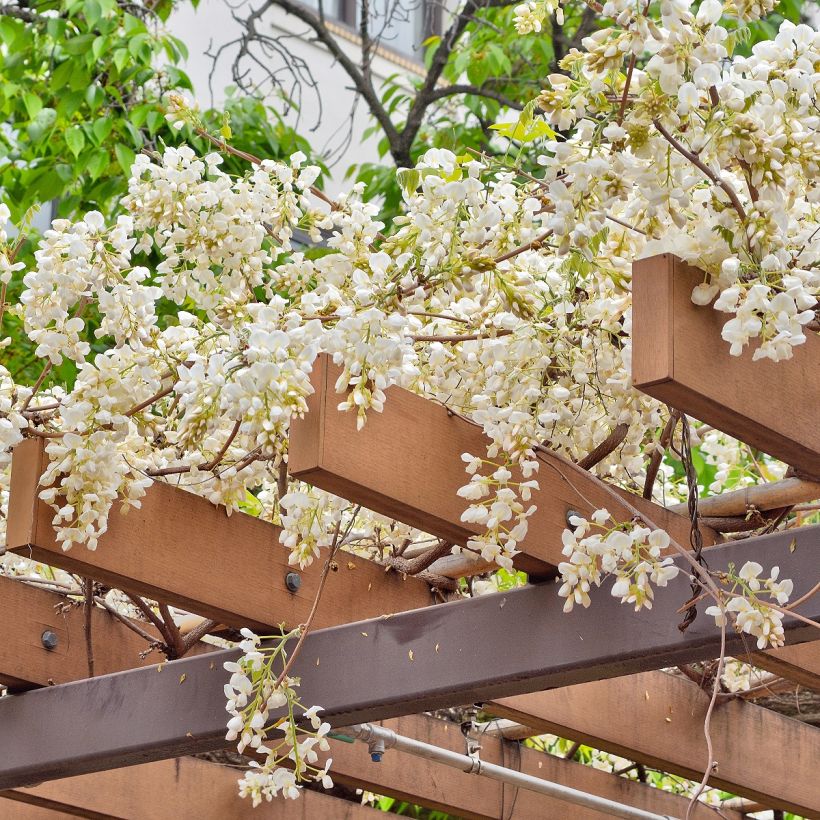

Plant habit
Flowering
Foliage
Safety measures
Botanical data
Wisteria
brachybotrys
White Silk
Fabaceae
Silky wisteria, Silken wisteria
Cultivar or hybrid
ingestion
Cette plante est toxique si elle est ingérée volontairement ou involontairement.
Ne la plantez pas là où de jeunes enfants peuvent évoluer, et lavez-vous les mains après l'avoir manipulée.
Pensez à conserver l'étiquette de la plante, à la photographier ou à noter son nom, afin de faciliter le travail des professionnels de santé.
Davantage d'informations sur https://plantes-risque.info
Other Wisterias
Planting and care
Wisteria 'White Silk' should be planted in autumn (October) or spring (March) in fertile, deep, and well-drained soil in a sunny location. Dig a hole 50x50x50cm (20x20x20in) and mix some compost with the existing soil. Soak the root ball in a bucket before planting to moisten it well, and water thoroughly after planting. It may be necessary to guide the young shoots to help the plant climb.
Do not apply any fertilisers, as this would promote vegetative growth at the expense of flowering. Nitrogen in particular should be avoided, as wisterias generally rely on soil reserves. In any case, they tend to flower better under slightly challenging conditions.
Planting period
Intended location
Care
This item has not been reviewed yet - be the first to leave a review about it.
Foolproof climbers
Haven't found what you were looking for?
Hardiness is the lowest winter temperature a plant can endure without suffering serious damage or even dying. However, hardiness is affected by location (a sheltered area, such as a patio), protection (winter cover) and soil type (hardiness is improved by well-drained soil).

Photo Sharing Terms & Conditions
In order to encourage gardeners to interact and share their experiences, Promesse de fleurs offers various media enabling content to be uploaded onto its Site - in particular via the ‘Photo sharing’ module.
The User agrees to refrain from:
- Posting any content that is illegal, prejudicial, insulting, racist, inciteful to hatred, revisionist, contrary to public decency, that infringes on privacy or on the privacy rights of third parties, in particular the publicity rights of persons and goods, intellectual property rights, or the right to privacy.
- Submitting content on behalf of a third party;
- Impersonate the identity of a third party and/or publish any personal information about a third party;
In general, the User undertakes to refrain from any unethical behaviour.
All Content (in particular text, comments, files, images, photos, videos, creative works, etc.), which may be subject to property or intellectual property rights, image or other private rights, shall remain the property of the User, subject to the limited rights granted by the terms of the licence granted by Promesse de fleurs as stated below. Users are at liberty to publish or not to publish such Content on the Site, notably via the ‘Photo Sharing’ facility, and accept that this Content shall be made public and freely accessible, notably on the Internet.
Users further acknowledge, undertake to have ,and guarantee that they hold all necessary rights and permissions to publish such material on the Site, in particular with regard to the legislation in force pertaining to any privacy, property, intellectual property, image, or contractual rights, or rights of any other nature. By publishing such Content on the Site, Users acknowledge accepting full liability as publishers of the Content within the meaning of the law, and grant Promesse de fleurs, free of charge, an inclusive, worldwide licence for the said Content for the entire duration of its publication, including all reproduction, representation, up/downloading, displaying, performing, transmission, and storage rights.
Users also grant permission for their name to be linked to the Content and accept that this link may not always be made available.
By engaging in posting material, Users consent to their Content becoming automatically accessible on the Internet, in particular on other sites and/or blogs and/or web pages of the Promesse de fleurs site, including in particular social pages and the Promesse de fleurs catalogue.
Users may secure the removal of entrusted content free of charge by issuing a simple request via our contact form.
The flowering period indicated on our website applies to countries and regions located in USDA zone 8 (France, the United Kingdom, Ireland, the Netherlands, etc.)
It will vary according to where you live:
- In zones 9 to 10 (Italy, Spain, Greece, etc.), flowering will occur about 2 to 4 weeks earlier.
- In zones 6 to 7 (Germany, Poland, Slovenia, and lower mountainous regions), flowering will be delayed by 2 to 3 weeks.
- In zone 5 (Central Europe, Scandinavia), blooming will be delayed by 3 to 5 weeks.
In temperate climates, pruning of spring-flowering shrubs (forsythia, spireas, etc.) should be done just after flowering.
Pruning of summer-flowering shrubs (Indian Lilac, Perovskia, etc.) can be done in winter or spring.
In cold regions as well as with frost-sensitive plants, avoid pruning too early when severe frosts may still occur.
The planting period indicated on our website applies to countries and regions located in USDA zone 8 (France, United Kingdom, Ireland, Netherlands).
It will vary according to where you live:
- In Mediterranean zones (Marseille, Madrid, Milan, etc.), autumn and winter are the best planting periods.
- In continental zones (Strasbourg, Munich, Vienna, etc.), delay planting by 2 to 3 weeks in spring and bring it forward by 2 to 4 weeks in autumn.
- In mountainous regions (the Alps, Pyrenees, Carpathians, etc.), it is best to plant in late spring (May-June) or late summer (August-September).
The harvesting period indicated on our website applies to countries and regions in USDA zone 8 (France, England, Ireland, the Netherlands).
In colder areas (Scandinavia, Poland, Austria...) fruit and vegetable harvests are likely to be delayed by 3-4 weeks.
In warmer areas (Italy, Spain, Greece, etc.), harvesting will probably take place earlier, depending on weather conditions.
The sowing periods indicated on our website apply to countries and regions within USDA Zone 8 (France, UK, Ireland, Netherlands).
In colder areas (Scandinavia, Poland, Austria...), delay any outdoor sowing by 3-4 weeks, or sow under glass.
In warmer climes (Italy, Spain, Greece, etc.), bring outdoor sowing forward by a few weeks.


































